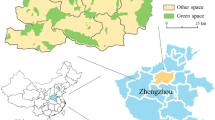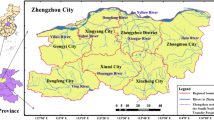Abstract
The emergy concept was used to evaluate a pumping irrigation water production system in China. A framework for emergy evaluation of the significance of irrigation water and its production process was developed. The results show that the irrigation water saved has the highest emergy value (8.73E + 05 sej·J−1), followed by the irrigation water supplied to farmlands (1.72E + 05 sej·J−1), the pumped water (4.81E + 04 sej·J−1), with the lowest value shown from water taken from the local river (3.72E + 04 sej·J−1). The major contributions to the emergy needed for production are the inputs of soil and water. This production system could contribute to the irrigated agriculture and economy, according to several calculated emergy indices: emergy yield ratio (EYR), emergy investment ratio (EIR), environmental load ratio (ELR), and environmental sustainability index (ESI). The comparative analysis shows that the emergy theory and method, different from the conventional monetary-based analysis, could be used to evaluate irrigation water and its production process in terms of the biophysical account. Additional emergy evaluations should be completed on different types of water production and irrigated agricultural systems to provide adequate guidelines for the sustainability of irrigation development.
Similar content being viewed by others
References
Adekalu K, Ogunjimi L (2003). Cost recovery strategy for large-scale irrigation projects in Nigeria. Technovation, 23(1): 77–83
Barton D N (2002). The transferability of benefit transfer: contingent valuation of water quality improvements in Costa Rica. Ecol Econ, 42(1–2): 147–164
Bebbington J, Brown J, Frame B (2007). Accounting technologies and sustainability assessment models. Ecol Econ, 61(2–3): 224–236
Blamey R, Gordon J, Chapman R (1999). Choice modelling: assessing the environmental values of water supply options. Aust J Agric Resour Econ, 43(3): 337–357
Brown M T, Martínez A, Uche J (2010). EEmergy analysis applied to the estimation of the recovery of costs for water services under the European Water Framework Directive. Ecol Modell, 221(17): 2123–2132
Brown M T, McClanahan T (1996). Emergy analysis perspectives of Thailand and Mekong River dam proposals. Ecol Modell, 91(1–3): 105–130
Brown M T, Ulgiati S (1997). Emergy-based indices and ratios to evaluate sustainability: monitoring economies and technology toward environmentally sound innovation. Ecol Eng, 9(1–2): 51–69
Bruinsma J (2003). World Agriculture: Towards 2015/2030: An FAO Perspective. London: Earthscan Publications Ltd.
Buenfil A A (2001). Emergy evaluation of water. Dissertation for Ph.D degree. Gainesville: University of Florida, USA
Cai X, McKinney D C, Rosegrant M W (2001). Sustainability Analysis for Irrigation Water Management: Concepts, Methodology and Application to the Aral Sea Region. Environment and Production Technology Division, International Food Policy Research Institute, Washington, DC, USA
Chen B, Chen G Q (2009). Emergy-based energy and material metabolism of the Yellow River basin. Commun Nonlinear Sci Numer Simul, 14(3): 923–934
Chen B, Chen Z, Zhou Y, Zhou J, Chen G (2009b). Emergy as embodied energy based assessment for local sustainability of a constructed wetland in Beijing. Commun Nonlinear Sci Numer Simul, 14(2): 622–635
Chen D, Chen J, Luo Z H (2012). Communications on emergy indices of regional water ecological-economic system. Ecol Eng, 46: 116–117
Chen D, Chen J, Luo Z H, Lv Z W (2009a). Emergy evaluation of the natural value of water resources in Chinese rivers. Environ Manage, 44(2): 288–297
Chen D, Webber M, Chen J, Luo Z H (2011). Emergy evaluation perspectives of an irrigation improvement project proposal in China. Ecol Econ, 70(11): 2154–2162
Chen G Q, Jiang M M, Chen B, Yang Z F, Lin C (2006). Emergy analysis of Chinese agriculture. Agric Ecosyst Environ, 115(1–4): 161–173
Chen S Q, Chen B (2011). Assessing inter-city ecological and economic relations: an emergy-based conceptual model. Frontiers of Earth Science, 5(1): 97–102
Costanza R, d’Arge R, de Groot R, Farber S, Grasso M, Hannon B, Limburg K, Naeem S, O’Neill R V, Paruelo J, Raskin R G, Sutton P, van den Belt M (1998). The value of the world’s ecosystem services and natural capital. Ecol Econ, 25(1): 3–15
Dinar A (2000). The Political Economy of Water Pricing Reforms. New York: Oxford University Press
Dudu H, Chumi S (2008). Economics of irrigation water management: a literature survey with focus on partial and general equilibrium models. World Bank Policy Research Working Paper Series, Vol 4556. Washington, DC: The World Bank
Faux J, Perry G M (1999). Estimating irrigation water value using hedonic price analysis: a case study in Malheur county, Oregon. Land Econ, 75(3): 440–452
Hau J L, Bakshi B R (2004). Promise and problems of emergy analysis. Ecol Modell, 178(1–2): 215–225
Hussain I, Bhattarai M (2005). Comprehensive assessment of socioeconomic impacts of agricultural water uses: concepts, approaches and analytical tools. A Draft Report of the Comprehensive Assessment of Water Management in Agriculture. Colombo: International Water management Institute
Hussain I, Turral H, Molden D, Ahmad M D (2007). Measuring and enhancing the value of agricultural water in irrigated river basins. Irrig Sci, 25(3): 263–282
Ingwersen W W (2010). Uncertainty characterization for emergy values. Ecol Modell, 221(3): 445–452
Jiang M M, Chen B, Zhou J B, Tao F R, Li Z, Yang Z F, Chen G Q (2007). Emergy account for biomass resource exploitation by agriculture in China. Energy Policy, 35(9): 4704–4719
Jiang W L (1998). The research of value-model assessment about value of water resource. Journal of natural resources, 1: 35–43
Johansson R C, Tsur Y, Roe T L, Doukkali R, Dinar A (2002). Pricing irrigation water: a review of theory and practice. Water Policy, 4(2): 173–199
Kang D, Park S S (2002). Emergy evaluation perspectives of a multipurpose dam proposal in Korea. J Environ Manage, 66(3): 293–306
Lan S F, Qin P, Lu H F (2002). Emergy Analysis of Eco-Economic System. Beijing: Chemical Industry Press
Li L, Lu H, Campbell D E, Ren H (2011). Methods for estimating the uncertainty in emergy table-form models. Ecol Modell, 222(15): 2615–2622
Lv C M, Wu Z N (2009). Emergy analysis of regional water ecological-economic system. Ecol Eng, 35(5): 703–710
Mareels I, Weyer E, Ooi S K, Cantoni M, Li Y, Nair G (2005). Systems engineering for irrigation systems: successes and challenges. Annu Rev Contr, 29(2): 191–204
Mayer A L (2008). Strengths and weaknesses of common sustainability indices for multidimensional systems. Environ Int, 34(2): 277–291
Mergos G J (1987). Evaluation of irrigation projects under uncertainty: a symmetric quadratic programming approach. Water Resour Manage, 1(1): 45–56
Michailidis A, Mattas K, Tzouramani I, Karamouzis D (2009). A socioeconomic valuation of an irrigation system project based on real option analysis approach. Water Resour Manage, 23(10): 1989–2001
Odum H T (1996). Environmental accounting: emergy and environmental decision making. New York: John Wiley & Sons
Olubode-Awosola O O, Idowu E O, Schalkwyk H D V (2006). Assessing irrigation projects performance for sustainable irrigation policy reform. Irrig Drain Syst, 20(2): 303–315
Playán E, Mateos L (2006). Modernization and optimization of irrigation systems to increase water productivity. Agric Water Manage, 80(1–3): 100–116
Psychoudakis A, Papoutsi-Psychoudaki S, McFarquhar A M M (1995). An economic assessment of an irrigation project affecting a Greek wetland. Wetlands Ecol Manage, 3(4): 225–232
Pulselli F M, Patrizi N, Focardi S (2011). Calculation of the unit emergy value of water in an Italian watershed. Ecol Modell, 222(16): 2929–2938
Pulselli R M, Simoncini E, Marchettini N (2009). Energy and emergy based cost-benefit evaluation of building envelopes relative to geographical location and climate. Build Environ, 44(5): 920–928
Qin C H, Gan H, Zhang X J, Jia L (2012). Study on water pricing method and practice: (2) discussion on water price of the Haihe Basin. J Hydraul Eng, 43(4): 429–436
Rosegrant M W, Cline S A (2003). Global food security: challenges and policies. Science, 302(5652): 1917–1919
Rugani B, Benetto E (2012). Improvements to Emergy evaluations by using Life Cycle Assessment. Environ Sci Technol, 46(9): 4701–4712
Sciubba E, Ulgiati S (2005). Emergy and exergy analyses: complementary methods or irreducible ideological options? Energy, 30(10): 1953–1988
Seyam I, Hoekstra A, Savenije H (2002). Calculation methods to assess the value of upstream water flows and storage as a function of downstream benefits. Phys Chem Earth Parts ABC, 27(11–22): 977–982
Shao L, Wu Z, Zeng L, Chen ZM, Zhou Y, Chen G Q (2012). Embodied energy assessment for ecological wastewater treatment by a constructed wetland. Ecol Modell, 252: 63–71
Shen D J, Liang R J, Wang H (1999). Water Pricing in Theory and Practice. Beijing: Science Press
Singh R, Refsgaard J, Yde L (1999). Application of irrigation optimisation system (IOS) to a major irrigation project in India. Irrig Drain Syst, 13(3): 229–248
Ulgiati S, Brown M T (1998). Monitoring patterns of sustainability in natural and man-made ecosystems. Ecol Modell, 108(1–3): 23–36
Wang A G (2012) The Interpretation of the National Outline for Agricultural Water-Saving Development in China (2012–2020). Beijing: The Ministry of Water Resources of China (MWR)
Ward F A (2010). Financing Irrigation Water Management and Infrastructure: a review. Water Resources Development, 26(3): 321–349
Yan M C, Odum H T (2001). New visual angle to view eco-economic system emergy evaluation case studies of Chinese regional ecoeconomic system. Beijing: China Zhigong Publishing House
Author information
Authors and Affiliations
Corresponding author
Additional information
Dan Chen earned his Ph.D in agricultural water and soil engineering from Hohai University, China in 2007. He is currently an Associate Professor in College of Water Conservancy and Hydropower Engineering, Hohai University. His research interests include irrigation development, water management, and ecological economics.
Zhaohui Luo earned her Ph.D in natural, biotic, and social environmental engineering from the University of Yamanashi, Japan in 2009. She is currently an Associate Professor in the College of Resources and Environmental Sciences, Nanjing Agricultural University. Her research interests include environmental engineering and management.
Michael Webber is a fellow of the Academy of Social Sciences in Australia. He graduated from the University of Cambridge in 1963 with first class honors in geography and subsequently undertook graduate training in agricultural economics and mathematics. He completed his Ph.D thesis on location and regional economic growth (Geography) at the Australian National University in 1967. He is currently a Professor in the Department of Resource Management and Geography, The University of Melbourne, Australia. His current research interests include water and environmental management in China.
Jing Chen earned her Ph.D from Tokyo University of Agriculture and Technology, Japan in 2000. She is currently a Professor and Associate Dean of the College of Water Conservancy and Hydropower Engineering, Hohai University. Her research interests include irrigation development and water management.
Weiguang Wang earned his Ph.D in water conservancy and hydropower engineering from Wuhan University, China in 2006. He is currently an Associate Professor in the College of Hydrology and Water Resources, Hohai University. His research interests include hydrology, irrigation development, and water management.
Rights and permissions
About this article
Cite this article
Chen, D., Luo, Z., Webber, M. et al. Emergy evaluation of a pumping irrigation water production system in China. Front. Earth Sci. 8, 131–141 (2014). https://doi.org/10.1007/s11707-013-0367-x
Received:
Accepted:
Published:
Issue Date:
DOI: https://doi.org/10.1007/s11707-013-0367-x




